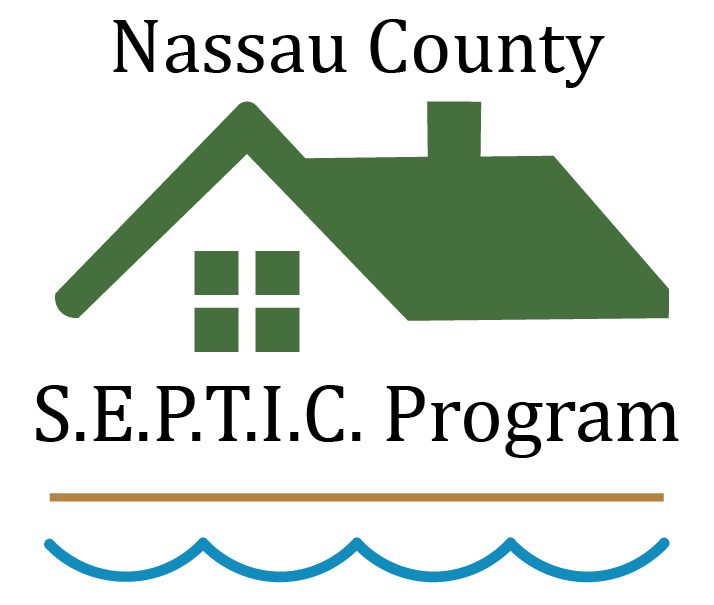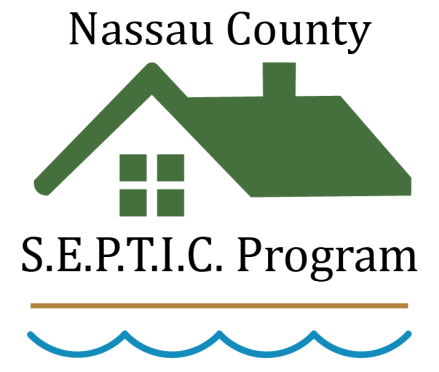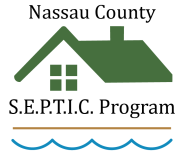

Nassau County has initiated a septic system replacement program for residents, small businesses, and non-profit organizations - Septic Environmental Program to Improve Cleanliness (S.E.P.T.I.C.). The SEPTIC program will provide grant funding to eligible recipients to replace a conventional or failing septic system with an innovative and alternative onsite wastewater treatment system.
Nassau County is offering grants up to $20,000 for homeowners or small businesses to install state-of-the-art nitrogen-reducing septic systems.
For more information, please contact us at SepticReplace@nassaucountyny.gov or (516) 364-5861
OR visit our page on the Nassau County website at www.nassaucountyny.gov/septicreplace
S.E.P.T.I.C. Program Overview
Nitrogen pollution from cesspools and septic systems has been identified as a leading cause of degraded surface water quality on Long Island, contributing to restrictions on shellfishing, toxic algae blooms, and massive fish kills. Approximately 40,000 residential properties on the North Shore of Nassau County are currently served by cesspools and septic systems. Reversing the degradation of water quality depends on the replacement of existing systems with new nitrogen-reducing technologies.
This need is addressed in Nassau County’s Nine Key Element Watershed Plan for Nitrogen, which advances efforts to restore and protect the water quality of the groundwater and embayments around Nassau County by recommending a variety of best management practices and actions, including the replacement of failing septic systems and cesspools with innovative alternative on-site treatment systems. Combined with the Long Island Nitrogen Action Plan (LINAP), the Nine Element Plan is part of the larger regional effort to coordinate nitrogen reduction efforts on the island.
In an effort to incentivize the use of these technologies and protect public and environmental health, Nassau County and New York State have created a septic system replacement program for eligible properties. The Septic Environmental Program to Improve Cleanliness (S.E.P.T.I.C.) provides grant funding of up to $20,000.00 to eligible homeowners, not-for-profits, and small businesses to replace conventional septic systems and cesspools with nitrogen-reducing innovative and alternative onsite wastewater treatment systems (IA OWTS).
Launched in May of 2021, the S.E.P.T.I.C. Program is administered by the Nassau County Soil and Water Conservation District (District) on behalf of Nassau County. The Program has been awarded over $8 million to fund approximately 400 upgrades to nitrogen-reducing technologies, of which 186 have been installed as of July 30, 2025.
Nassau’s S.E.P.T.I.C. Program – Qualifying Properties
- Single and two-family homes, not-for-profit organizations, small businesses, and municipalities.
- Organizations with a sanitary design flow of less than 1,000 gallons per day (GPD)
-
Replacement of an existing septic system or cesspool with a new nitrogen-reducing IA OWTS
- Both the design and construction of any replacement must have been approved by the local permitting authority.
- Must have no tax liens or active foreclosure actions.
-
Must have a valid certificate of occupancy (CO) or equivalent issued by the pertinent city, town, or village.
- Must be served by an existing septic system or cesspool and not be connected to a public or private sewer or located within an existing or proposed sewer district.
- If the property is located in an existing sewer district but is unable to connect due to site constraints documented by the Sewer District in question, the property may be eligible, provided the applicant meets all other eligibility requirements
Nassau County S.E.P.T.I.C. Program Funds are not considered taxable income as they provide a community health benefit.

Additional Resources and S.E.P.T.I.C. Program Documents

Check for Sewer Service - Review your Nassau County tax assesment to determine if you are in a proposed sewer district. Simply enter your Address, and review your general taxes to check for Sewer.
Homeowner Resources - For Homeowners and property owners signed up for the S.E.P.T.I.C. Program.
Industry Resources - For Installers or Designers interested in Participating in the program. Here you will find guidance memos and resources that outline the program rules and guidelines.
Guidance Memo #1 - Nassau County S.E.P.T.I.C. Program Rules
Guidance Memo #2 - I.A. Substitution Guidelines
Guidance Memo #3 - Program Guidelines for Instances where NYS Setbacks may be Relaxed for Repairs and Retrofits of Existing Systems with Nitrogen-Reducing IA Systems
Nassau County Health Department comments on Guidance Memo #3 - Generic 75-A Guidance to Local Jurisdictions for Nassau County's S.E.P.T.I.C. Grant Program / Comments from Nassau County Department of Health
Final Guidelines for the Acceptance Use and Management of IA OWTS - Guidelines for the Acceptance, Use, and Management of IA OWTS for Nassau County's S.E.P.T.I.C. Grant Program
Applicants Currently Enrolled
Photos from Septic System Installations
Frequently Asked Questions
How do the approved technologies reduce nitrogen?
The approved nitrogen-reducing technologies (also known as Innovative and Alternative Onsite Waste Treatment Systems or IAOWTS, or Clean Water Septic Systems) use filtration and biological processes to ultimately convert the organic nitrogen found in wastewater into harmless nitrogen gas. This is commonly achieved by using separate compartments in the septic tank. The first compartment is typically anoxic, meaning there is no oxygen present in the wastewater. This compartment also contains human waste which is a good source of carbon to feed the “good” bacteria that denitrify or convert nitrate nitrogen to harmless nitrogen gas. The second compartment usually introduces oxygen through filters, blowers, or aerators to convert the ammonium in wastewater to nitrate nitrogen. This effluent is now much cleaner, but it needs to be sent to a carbon rich anaerobic environment for denitrification, which occurs when aerobic bacteria, now starved in an oxygen depleted environment, strip the oxygen molecule from the nitrate (a form of nitrogen), resulting in the release of gaseous nitrogen harmlessly into the atmosphere. The nitrogen cycle is one of Earth’s most important biological processes, second only to photosynthesis.
How does a Clean Water Septic System (IA OWTS) benefit the property owner?
In addition to providing environmental benefits and reducing the nitrogen load to ground and surface waters, property owners receive many other benefits from these state-of-the-art technologies. IA OWTS can be more cost effective than conventional systems on lots with significant site constraints such as high groundwater, poor soils, small restrictive lot size, and coastal areas. In addition, IA OWTS consist of separate components, all of which are replaceable if something goes wrong. A property owner may have to replace a pump or blower after 10 years but should not have to dig up and replace the system as is common with conventional systems. Finally, in some instances, installing an IA OWTS system has been shown to increase property values.
How does a Clean Water Septic System (IA OWTS) benefit the environment?
Conventional septic systems and cesspools are not designed to remove nitrogen. As a result, nitrogen in sewage easily seeps into the ground, then to groundwater, and ultimately to our bays and harbors where they can lead to excess nitrogen. Too much nitrogen can lead to algae blooms (some of which are toxic to humans) which, when these blooms die off, can deplete the bay of oxygen needed by fish and other marine life. In addition, excess nitrogen can lead to the loss of wetland marshes as their roots become too shallow to withstand storms and other disturbance. Since these wetlands protect Long Island’s shorelines from storms, serve as a natural filter for stormwater, and provide habitat for marine life, their destruction can cause significant negative impacts. IA OWTS systems have been shown to remove up to 90% of the nitrogen that leads to these problems.
Which pollutants, other than nitrogen, does the system treat for, if any?
IA OWTS are designed to reduce wastewater nitrogen, biochemical oxygen demand (BOD), and total suspended solids before being discharged below grade to leaching structures. Please consult with the manufacturer (or authorized installer) of your I/A system to learn more about the capabilities of their specific technology. Although studies have shown that certain IA OWTS systems may reduce other pollutants, the purpose of this program is to address and reduce the prevalence of nitrogen in our waterways.
What are the electrical demands?
I/A OWTS electrical consumption varies from system to system due to different treatment processes with different pumps and blowers required to treat the wastewater. Of the systems that have been provisionally approved, annual electric costs are currently estimated to range from $100 to $300 per year. Please consult with the manufacturer (or authorized installer) regarding your IA OWTS system’s power needs. It is important that you ask if pumps will need to be installed with your project (typical with basement bathrooms and areas with high groundwater) and what backup power solutions are necessary in the event of power loss to your home.
What kind of maintenance is required for these systems?
IA OWTS systems require inspection and maintenance at least once per year, though most technologies are maintained every 6 months. The maintenance typically includes cleaning filters, pumps, and floats, measuring oxygen levels, and ensuring the system controls are optimized for nitrogen removal. The service provider will also monitor the solids in the tank and recommend pumping as needed. As part of the grant, a three-year maintenance agreement is required and is an out of pocket expense for the applicant. A number of installers on our pre-approved list are qualified to preform operation and maintenance, but not all. If your installer is not qualified to preform operation and maintenance, please contact the Nassau Soil & Water Conservation District for additional resources. Maintenance agreements are required for the life of the system and proof must be shown to the County or its designated agent each year. Reminders will be automatically emailed to grant recipients each year. Typically, maintenance agreements cost about $300 per year. Proper maintenance helps ensure that these systems continue to remove nitrogen as designed (the purpose of the grants). Failure to provide the County with proof of a maintenance contract may result in the obligation to repay the amount of the grant.
Questions Regarding S.E.P.T.I.C. Grant Program
If we want to upgrade to reduce our nitrogen output and our system is ancient but not failing (yet), are we eligible for a S.E.P.T.I.C. Grant to install an IA OWTS?
Yes! The New York State Department of Environmental Conservation (NY DEC) has determined that conventional septic systems and cesspools on Long Island are considered failing since they are neither designed, nor capable of removing significant amounts of nitrogen.
If we meet all the eligibility requirements is there any other reason why the grant would not be given?
Yes, as of 2024, there are currently enough County and State funds for 403 grants. Provisional grant acceptance is given on a first-come, first-served basis to qualified applicants. If demand for the Program exceeds available funding, the District reserves the right to modify program rules to set more restrictive criteria to prioritize the most environmentally sensitive areas.
If I have an I/A-OWTS installed with a grant from the S.E.P.T.I.C. Program, can I remove the unit or make it inoperable?
No, the conditions of funding do not allow for removal or deactivation. Be sure you are committed to this system and its maintenance requirements before applying for a grant.
Must a recipient maintain service in perpetuity?
Yes, the recipient is responsible for ensuring that their grant-funded system is inspected and maintained at least once per year by a licensed service provider.
Does the process require any approvals?
Design professionals (licensed engineer or architect) should help residents understand which permits would be required for electric, plumbing, wetlands, or dewatering. It is recommended that a property owner’s selected design professional check with the local town/village/city building department to verify if a permit is required for the I/A OWTS electrical work or for any internal plumbing modifications if required in addition to a building permit. For residents in close proximity to surface waters and/or wetlands, their selected design professional should check with the NYS DEC and/or Town/Village/City to determine if a permit is required due to setbacks to surface waters or wetlands.
Are the materials exempt from sales tax because the project is considered a capital improvement?
Applicants must consult their tax professional regarding any tax exemptions, requirements, or other tax implications that may exist. Please note that the County / District does not provide tax advice to applicants, so applicants are advised to consult their tax professional regarding sales tax exemptions. However, if applicable, applicants must submit NYS Capital Improvement Sales Tax Exemption Form ST-124 in accordance with NYS Requirements.
Are the grant funds taxable?
No. The IRS has determined that these grants constitute a community benefit, and 1099 forms will not be issued to program participants.
Design considerations
A comprehensive soil and site investigation will identify the preferred location and the type of system that is appropriate for the site conditions. Separation distances between IA OWTS components and property boundaries, structures (existing or planned) and other site features are necessary. The required infiltrative area is determined from: (a) properly conducted soil percolation and deep hole tests to accurately identify the site and soil conditions and (b) projected wastewater dispersion direction.
How do I measure the treatment capabilities of my current system and confirm whether or not it is less than 1,000 gallons per day?
Depending on Town, Village. Or City requirements, IA OWTS systems are sized between 110 and 150 gallons of treatment capacity per bedroom per day. In most cases, up to 9-bedroom single-family residences are generally eligible for S.E.P.T.I.C. grant assistance.
For small businesses, not-for-profits, or other buildings, a good guide to measure if your building discharges less than 1,000 gpd is to look at your water bill and usage. For specific design and system sizing requirements please refer to NYS Department of Health Appendix 75-A Wastewater Treatment Standards – Residential Onsite.
Yes, assuming the total daily design flow is less than 1,000 gallons per day. However, please note that grant awards are limited to one award per property.
I have more than one building on my property utilizing the same system, would I be eligible for an IA OWTS upgrade?
Yes, assuming the total combined design flow for both buildings is less than 1,000 gallons per day.
Does the S.E.P.T.I.C. grant program reimburse sales tax?
No, sales tax is an ineligible cost and will not be reimbursed.
What are the FEMA flood zone construction requirements?
Your design professional can provide you with the regulatory and manufacturer requirements for your FEMA Designated Flood Zone.
If grant funds cannot be used for new construction, what about substantial reconstruction?
Grant funds can be used for repairs to an existing system using IA OWTS technology. Therefore, if the property is undergoing reconstruction, but has a previous system in place prior to March 1, 2018, it would be eligible under the program.
I am building a new house and wish to install an IA OWTS system. Would I be eligible for the program?
While new construction is not eligible for the program, if there is a current system in place for the property (i.e. the old house was demolished in order to build a new one) that has existed since before March 1, 2018, the property would be eligible for an upgrade to an I\A OWTS system under the program.
Can I apply for the S.E.P.T.I.C. Grant Program retroactively?
Yes, you may apply retroactively to the installation of an IA OWTS system as long as the system was installed after March 1, 2018. However, applying does not guarantee that you will receive a grant award. Grants are subject to limitations and availability of funding and all other requirements.
What costs are eligible for reimbursement through this program?
To be eligible for reimbursement, an incurred cost must be reasonable and necessary for work done on a septic system if it is determined by the County or its authorized agent. Eligible costs are listed below:
-
design and installation costs, and costs of the system, system components, or enhanced treatment technologies. Note that grant funds must first be used to pay for installation costs and if funds remain after this, they can be used to reimburse the property owner for some or all design costs.
-
design costs are eligible (subject to the above), limited only to work needed to complete an approved design, including needed site investigation. Note that design costs will only be reimbursed if funds remain after covering installation costs.
-
the purchase of electrical components associated with the IA OWTS.
-
labor costs incurred in connection with installation, excavation and/ or backfilling of the IA OWTS and any necessary leaching fields and structures.
-
a three-year warranty for the IA OWTS.
What costs are ineligible for reimbursement through this program?
-
irrigation repairs.
-
non-essential site beautification.
-
electrical improvements unrelated to the IA OWTS.
-
any other improvements not necessary for the installation of the system.
-
sales tax or fines and penalties.
-
routine maintenance such as a pump out of a septic tank.
-
any operation and maintenance expenses.
-
any expenses that are not appropriately documented.
-
government permit fees, including but not limited to fees assessed for building permits, zoning permits, construction compliance certifications, and floodplain disturbance permits.
-
interest and late fees.
-
interior plumbing changes.
-
administrative work conducted by the engineer.
-
construction observation by the engineer if the engineer, or an entity owned, controlled by, or employing the engineer, is also conducting the repair or replacement.
-
pumping and abandonment of an existing on-site system.
We presently have two cesspools for a single-family home - one for solid waste and an overflow for wastewater. Would we qualify for the program?
Yes, as long as the daily design flow is less than 1,000 gallons per day.
Are properties owned by not-for-profit organizations or local governments eligible for the grants?
Yes, they are eligible, provided that the daily design flow is less than 1,000 gallons per day.
Are employees of Nassau County, New York State, local governments, or the federal government eligible to apply?
Yes, they are eligible.
If my property is in an area with sewer service or proposed for sewer service, am I eligible to apply?
Eligible program applicants must be served by an existing sanitary septic system or cesspool and not be connected to a public or private sewer or located within an existing or proposed sewer district, unless the property meets one of the following exceptions:
-
If the property is located in an existing sewer district but is unable to connect due to site constraints documented by the Sewer District in question, the property may be eligible, provided the applicant meets all other eligibility requirements; or
-
a qualifying Residential Parcel may, at the sole discretion of the County, be located in a proposed sewer district where such Residential Parcel is served by an existing septic system or cesspool, and there is documentation that such septic system or cesspool has failed or is failing
How do I find contractors to design and install my system?
You will need both a design professional (licensed engineer or architect) to design your system and an Installer to install your system. New York State law does not allow the same firm to both design and install systems. The County and the Nassau County Soil and Water Conservation District solicit proposals from designers and installers whereby they provide their qualifications and licenses. Once approved by the District and the County, this information is posted on the S.E.P.T.I.C. Program website (www.nassaucountyny.gov/septicreplace). This list is available here and regularly updated. Note that installers must have a Nassau County Home Improvement License issued by the Nassau County Department of Consumer Affairs.

